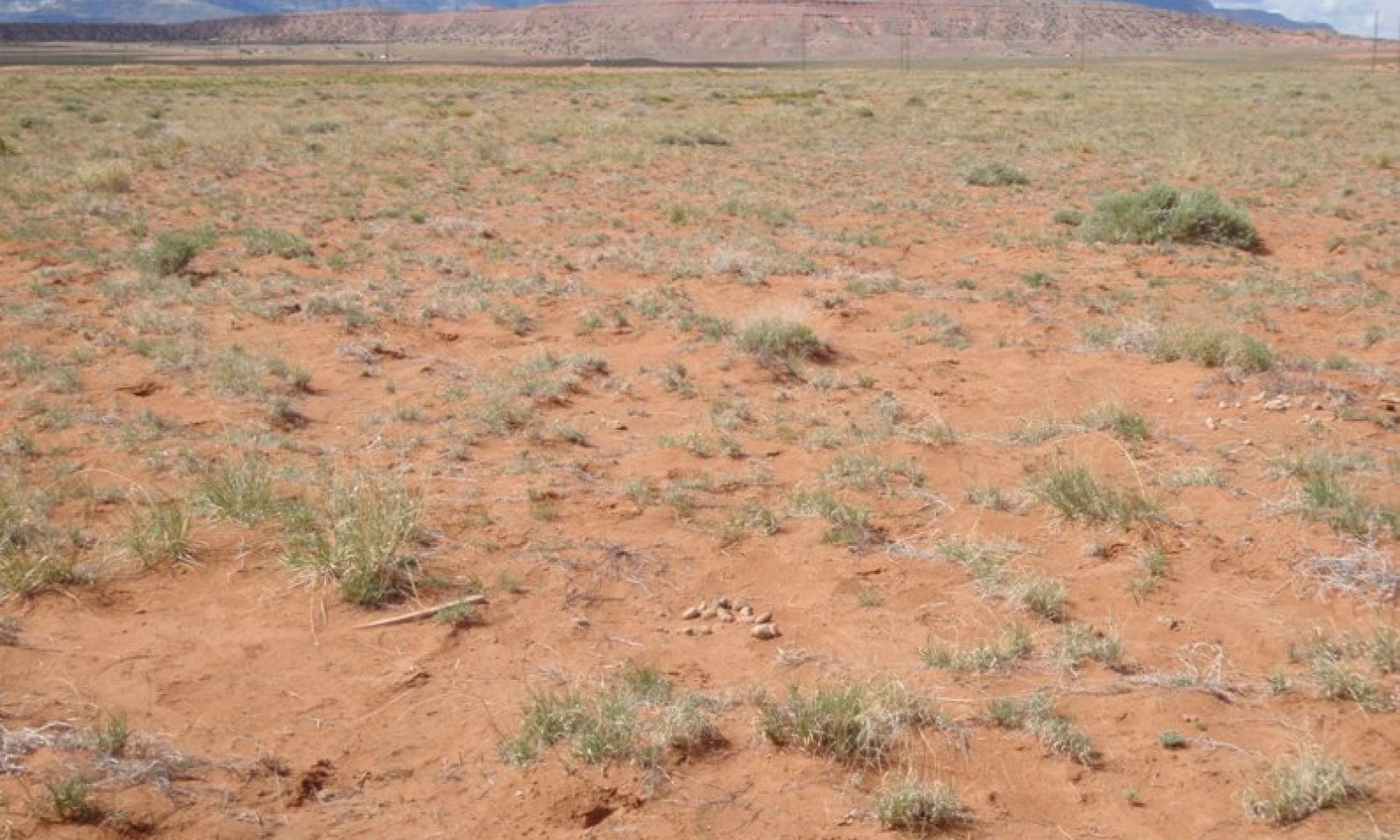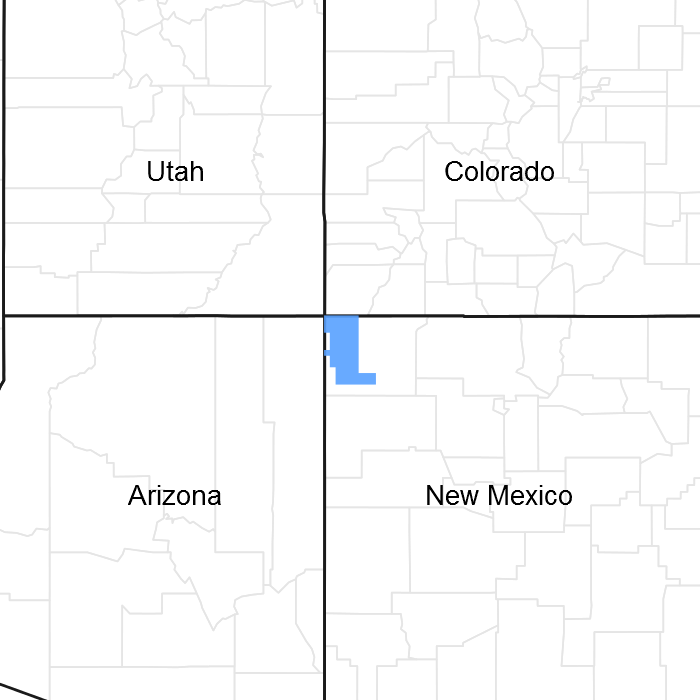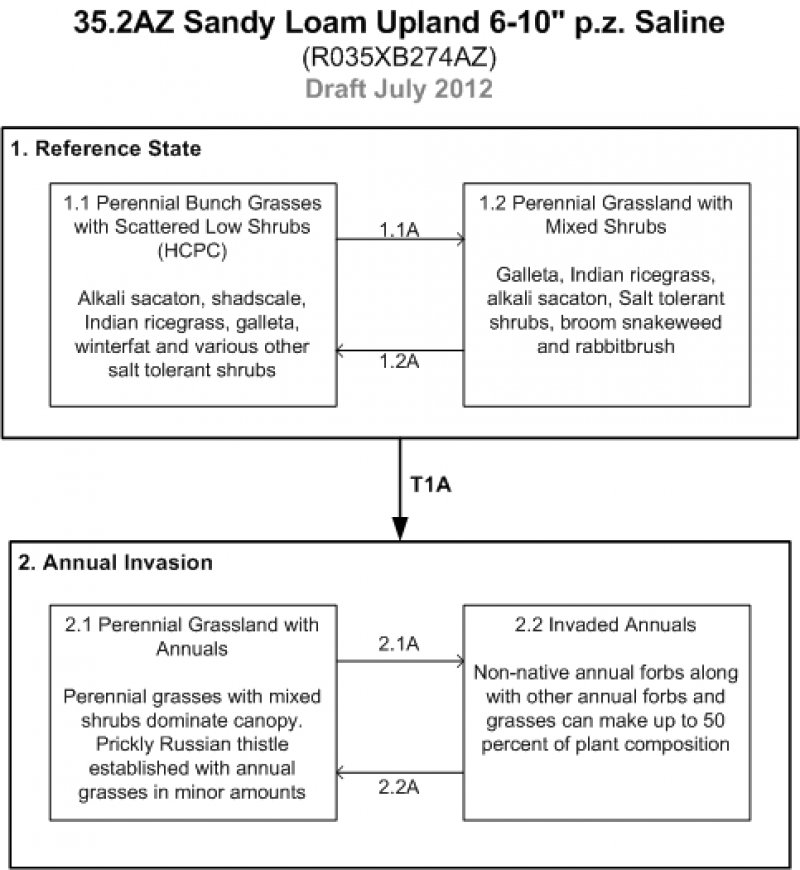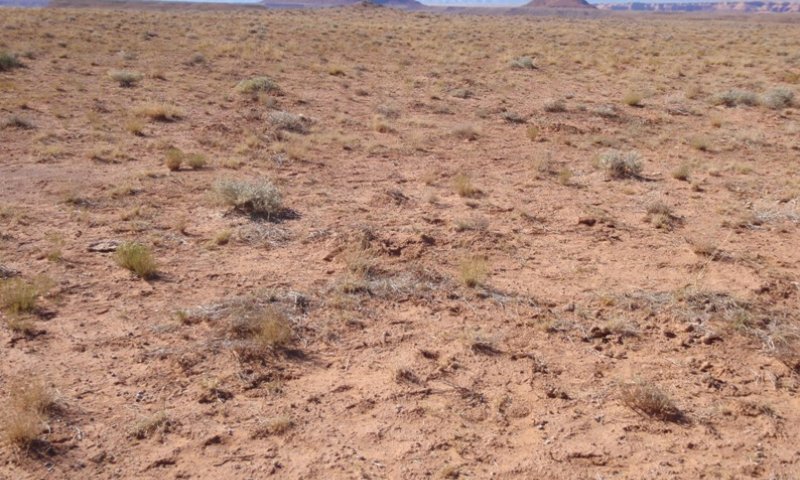

Natural Resources
Conservation Service
Ecological site R035XB274AZ
Sandy Loam Upland 6-10" p.z. Saline
Last updated: 5/20/2025
Accessed: 12/08/2025
General information
Provisional. A provisional ecological site description has undergone quality control and quality assurance review. It contains a working state and transition model and enough information to identify the ecological site.

Figure 1. Mapped extent
Areas shown in blue indicate the maximum mapped extent of this ecological site. Other ecological sites likely occur within the highlighted areas. It is also possible for this ecological site to occur outside of highlighted areas if detailed soil survey has not been completed or recently updated.
MLRA notes
Major Land Resource Area (MLRA): 035X–Colorado Plateau
AZ CRA 35.2 - Colorado Plateau Shrub – Grasslands
Elevations range from 3500-5500 feet and precipitation averages 6 to 10 inches per year. Vegetation includes shadscale, fourwing saltbush, Mormon tea, blackbrush, Indian ricegrass, galleta, blue grama, and black grama. The soil temperature regime is mesic and the soil moisture regime is typic aridic. This unit occurs within the Colorado Plateau Physiographic Province and is characterized by a sequence of flat to gently dipping sedimentary rocks eroded into plateaus, valleys and deep canyons. Sedimentary rock classes dominate the plateau with volcanic fields occurring for the most part near its margin.
Ecological site concept
This site occurs on a number of landforms and landform positions with slopes of 0 to 15 percent.
The soils are moderately deep to very deep and well drained. Surface textures include loamy fine sand, fine sandy loam, gravelly loamy sand and very fine sandy loam. EC ranges from 4 to 16 mmhos/cm; SAR ranges from 5 to 30.
Table 1. Dominant plant species
| Tree |
Not specified |
|---|---|
| Shrub |
(1) Atriplex confertifolia |
| Herbaceous |
(1) Sporobolus airoides |
Physiographic features
This site occurs on toeslopes of undulating plateaus and cuestas; dipslopes of cuestas; summits of plateaus and structural benches; knolls of plateaus, mesas and benches; fan remnants; and treads of high stream terraces.
This site is in an upland position and neither benefits from run-in moisture from adjacent areas nor does it sustain excessive loss from runoff. It occurs on all exposures.
Table 2. Representative physiographic features
| Landforms |
(1)
Plateau
(2) Cuesta (3) Mesa |
|---|---|
| Flooding frequency | None to very rare |
| Ponding frequency | None to rare |
| Elevation | 1,463 – 1,920 m |
| Slope | 0 – 15% |
| Aspect | Aspect is not a significant factor |
Climatic features
The climate of the land resource unit is arid with warm summers and cool winters. This is one of the driest land resource units on the Colorado Plateau with an average annual precipitation ranging from 6 to 10 inches per year. It is also very erratic, often varying substantially from year to year. 40 to 50 percent of the precipitation is received from October through early May. This precipitation comes as gentle rain or snow from frontal storms coming out of the Pacific Ocean. Snow is common from November through February. Generally no more than an inch or two of snow accumulates and usually melts within a day or two. The remaining precipitation, approximately 50 to 60 percent, is received from July through September as spotty, unreliable and sometimes violent thunderstorms. The moisture for this precipitation originates in the Gulf of Mexico (and the Pacific Ocean in the fall) and flows into the area on the north end of the Mexican monsoon. Late May through late June is generally a dry period. The mean annual temperature ranges from 53 to 56 degrees Fahrenheit (F). The frost-free period (air temperature > 32 degrees F) ranges from 135 to 160 days (@ 50 percent probability). Strong winds are common, especially in the spring.
Table 3. Representative climatic features
| Frost-free period (average) | 160 days |
|---|---|
| Freeze-free period (average) | 184 days |
| Precipitation total (average) | 254 mm |
Figure 2. Monthly precipitation range
Figure 3. Monthly average minimum and maximum temperature
Influencing water features
This is an upland site, and is not associated with water features or wetlands. During heavy rain events, this site may receive run-on moisture from landforms above and contribute runoff to landforms below.
Soil features
The soils are moderately deep to very deep and well drained. The are formed in alluvium, residuum and eolian derived from sandstone, shale, quartzite and tuff-breccia.
Surface textures include loamy fine sand, fine sandy loam, gravelly loamy sand and very fine sandy loam.
Subsurface textures include fine sandy loam channery fine sandy loam, very fine sandy loam, sandy clay loam, cobbly sandy clay loam, sandy loam, loamy fine sand and gravelly loamy sand.
Siltstone is at a depth of 34 inches for the moderately deep soils and soft sandstone at a depth of about 42 to 60 inches for the deep soils. The hazard of water erosion is slight to moderate and ght hazard of soil blowing is severe.
Typical taxonomic units include:
SSA-713 Chinle Area MU's 1001 & 1011 Marcou;
SSA-715 Fort Defiance Area AZ/NM MU 19 Brimhall family;
SSA 717 Shiprock Area NM/AZ - MU's 110 Brimhall part, 125 Kimbeto, 180 Kimbeto part, 215 Fordbutte part, 235 Wingrock part and 265 Kimbeto part.
Table 4. Representative soil features
| Parent material |
(1)
Alluvium
–
sandstone and shale
(2) Residuum – quartzite (3) Eolian deposits – tuff breccia |
|---|---|
| Surface texture |
(1) Loamy fine sand (2) Fine sandy loam (3) Gravelly loamy sand |
| Family particle size |
(1) Loamy |
| Drainage class | Moderately well drained to well drained |
| Permeability class | Moderately slow to moderately rapid |
| Soil depth | 102 – 203 cm |
| Surface fragment cover <=3" | 15 – 30% |
| Available water capacity (0-101.6cm) |
6.35 – 17.78 cm |
| Calcium carbonate equivalent (0-101.6cm) |
5 – 20% |
| Electrical conductivity (0-101.6cm) |
4 – 16 mmhos/cm |
| Sodium adsorption ratio (0-101.6cm) |
5 – 30 |
| Soil reaction (1:1 water) (0-101.6cm) |
7.4 – 9.2 |
| Subsurface fragment volume <=3" (Depth not specified) |
5 – 15% |
Ecological dynamics
The plant communities found on an ecological site are naturally variable. Composition and production will vary with yearly conditions, location, aspect, and the natural variability of the soils. The historical climax plant community represents the natural potential plant communities found on relict or relatively undisturbed sites. Other plant communities described here represent plant communities that are known to occur when the site is disturbed by factors such as grazing, fire, or drought.
Production data provided in this site description is standardized to air-dry weight at the end of the summer growing season. The plant communities described in this site description are based on near normal rainfall years.
NRCS uses a Similarity Index to compare existing plant communities to the plant communities described here. Similarity Index is determined by comparing the production and composition of a plant community to the production and composition of a plant community described in this site description. To determine Similarity Index, compare the production (air-dry weight) of each species to that shown in the plant community description. For each species, count no more than the maximum amount shown for the species, and for each group, count no more than the maximum shown for the group. Divide the resulting total by the total normal year production shown in the plant community description. If rainfall has been significantly above or below normal, use the total production shown for above or below normal years. If field data is not collected at the end of the summer growing season, then the field data must be corrected to the end of the year production before comparing it to the site description. The growth curve can be used as a guide for estimating production at the end of the summer growing season.
State and transition model

Figure 4. Sandy Loam Upland 6-10" p.z. Saline State and Transition Model. Transition T1A denotes colonization by annuals. Pathways 1.1A and 2.1A denote continuous grazing. 1.2A and 2.2A denote prescribed grazing.
More interactive model formats are also available.
View Interactive Models
More interactive model formats are also available.
View Interactive Models
Click on state and transition labels to scroll to the respective text
Ecosystem states
State 1 submodel, plant communities
State 1
Reference State
This state represents the most ecologically stable conditions in terms of resistance to erosion. Moreover, this state has the highest potential for productivity and plant diversity.
Community 1.1
Reference Plant Community

Figure 5. Sandy Loam Upland 6-10" p.z. Saline

This plant community is made up primarily of grasses with some shrubs and minor amounts of forbs. In the original plant community there is a mixture of both cool and warm season grasses. The salinity of the soil incluences the kinds of plants in the community. Plant species most likely to invade or increase on this site when it deteriorates are Russian thistle, annual mentzelia, alkali sacaton, and shadscale. Continuous grazing during the winter and spring periods will decrease the cool season grasses, which are replaced by warm season, lower forage value grasses and shrubs
Figure 6. Annual production by plant type (representative values) or group (midpoint values)
Table 5. Annual production by plant type
| Plant type | Low (kg/hectare) |
Representative value (kg/hectare) |
High (kg/hectare) |
|---|---|---|---|
| Grass/Grasslike | 280 | 347 | 404 |
| Shrub/Vine | 101 | 146 | 179 |
| Forb | 6 | 22 | 34 |
| Total | 387 | 515 | 617 |
Figure 7. Plant community growth curve (percent production by month). AZ3521, 35.2 6-10" p.z. all sites. Growth begins in the spring and continues through the summer. Most growth in this CRA occurs in the spring using stored winter moisture..
| Jan | Feb | Mar | Apr | May | Jun | Jul | Aug | Sep | Oct | Nov | Dec |
|---|---|---|---|---|---|---|---|---|---|---|---|
| J | F | M | A | M | J | J | A | S | O | N | D |
| 0 | 1 | 9 | 20 | 27 | 14 | 10 | 11 | 5 | 3 | 0 | 0 |
Figure 8. Plant community growth curve (percent production by month). AZ5201, 35.2 6-10" p.z. galleta. Growth begins in spring, most growth occurs during summer rains..
| Jan | Feb | Mar | Apr | May | Jun | Jul | Aug | Sep | Oct | Nov | Dec |
|---|---|---|---|---|---|---|---|---|---|---|---|
| J | F | M | A | M | J | J | A | S | O | N | D |
| 0 | 0 | 5 | 10 | 20 | 10 | 15 | 35 | 5 | 0 | 0 | 0 |
Figure 9. Plant community growth curve (percent production by month). AZ5202, Indian ricegrass, 35.2 6-10" p.z.. Growth begins in spring, most growth occurs in May, goes dormant during summer heat..
| Jan | Feb | Mar | Apr | May | Jun | Jul | Aug | Sep | Oct | Nov | Dec |
|---|---|---|---|---|---|---|---|---|---|---|---|
| J | F | M | A | M | J | J | A | S | O | N | D |
| 0 | 0 | 10 | 15 | 40 | 20 | 0 | 0 | 10 | 5 | 0 | 0 |
Figure 10. Plant community growth curve (percent production by month). AZ5203, 35.2 6-10" p.z. alkali sacaton. Growth begins in the spring, most growth occurs in the summer, goes dormant in the fall..
| Jan | Feb | Mar | Apr | May | Jun | Jul | Aug | Sep | Oct | Nov | Dec |
|---|---|---|---|---|---|---|---|---|---|---|---|
| J | F | M | A | M | J | J | A | S | O | N | D |
| 0 | 0 | 5 | 10 | 20 | 10 | 20 | 20 | 10 | 5 | 0 | 0 |
Additional community tables
Table 6. Community 1.1 plant community composition
| Group | Common name | Symbol | Scientific name | Annual production (kg/hectare) | Foliar cover (%) | |
|---|---|---|---|---|---|---|
|
Shrub/Vine
|
||||||
| 0 | 101–146 | |||||
| shadscale saltbush | ATCO | Atriplex confertifolia | 50–101 | – | ||
| Shrub (>.5m) | 2SHRUB | Shrub (>.5m) | 0–26 | – | ||
| wheelscale saltbush | ATELF | Atriplex elegans var. fasciculata | 0–16 | – | ||
| winterfat | KRLA2 | Krascheninnikovia lanata | 0–10 | – | ||
| plains pricklypear | OPPO | Opuntia polyacantha | 0–6 | – | ||
| mound saltbush | ATOB | Atriplex obovata | 0–6 | – | ||
| valley saltbush | ATCU | Atriplex cuneata | 0–6 | – | ||
|
Grass/Grasslike
|
||||||
| 0 | 280–325 | |||||
| alkali sacaton | SPAI | Sporobolus airoides | 127–151 | – | ||
| James' galleta | PLJA | Pleuraphis jamesii | 50–76 | – | ||
| Indian ricegrass | ACHY | Achnatherum hymenoides | 50–76 | – | ||
| Grass, perennial | 2GP | Grass, perennial | 0–26 | – | ||
| squirreltail | ELELE | Elymus elymoides ssp. elymoides | 0–26 | – | ||
| sand dropseed | SPCR | Sporobolus cryptandrus | 0–16 | – | ||
| Fendler's threeawn | ARPUF | Aristida purpurea var. fendleriana | 0–6 | – | ||
|
Forb
|
||||||
| 0 | 6–22 | |||||
| Forb, perennial | 2FP | Forb, perennial | 0–16 | – | ||
| Forb, annual | 2FA | Forb, annual | 0–10 | – | ||
| rose heath | CHER2 | Chaetopappa ericoides | 0–6 | – | ||
| widewing springparsley | CYPU | Cymopterus purpurascens | 0–6 | – | ||
| globemallow | SPHAE | Sphaeralcea | 0–6 | – | ||
Interpretations
Animal community
This site is suitable for year-long grazing by all classes of livestock. Grazing systems adapt well to this site and should be used. This site has a high wind erosion hazard and with site deterioration, erosion occurs on overgrazed areas, roads, animal trails and concentration areas.
This site is preferred by digging animals. The lack of water and cover limits the use of the area by large mammals to foraging.
Recreational uses
The grassy aspect on the undulating plateaus, tilted uplands and structural benches gives a good aesthetic appeal.
The winters are cold and spring time is usually windy. The summers are mild with typical southwest thunderstorms.
Occasional recreational activities are horseback riding, wildlife observation and hunting.
Supporting information
Type locality
| Location 1: San Juan County, NM | |
|---|---|
| Township/Range/Section | T27N R18W S23 |
| General legal description | Table Mesa quad about 2.5 miles south of Table Mesa - Navajo Reservation, NM. |
Contributors
Harmon Hodgkinson
Karlynn Huling
Larry D. Ellicott
Rangeland health reference sheet
Interpreting Indicators of Rangeland Health is a qualitative assessment protocol used to determine ecosystem condition based on benchmark characteristics described in the Reference Sheet. A suite of 17 (or more) indicators are typically considered in an assessment. The ecological site(s) representative of an assessment location must be known prior to applying the protocol and must be verified based on soils and climate. Current plant community cannot be used to identify the ecological site.
| Author(s)/participant(s) | |
|---|---|
| Contact for lead author | |
| Date | 12/08/2025 |
| Approved by | Kendra Moseley |
| Approval date | |
| Composition (Indicators 10 and 12) based on | Annual Production |
Indicators
-
Number and extent of rills:
-
Presence of water flow patterns:
-
Number and height of erosional pedestals or terracettes:
-
Bare ground from Ecological Site Description or other studies (rock, litter, lichen, moss, plant canopy are not bare ground):
-
Number of gullies and erosion associated with gullies:
-
Extent of wind scoured, blowouts and/or depositional areas:
-
Amount of litter movement (describe size and distance expected to travel):
-
Soil surface (top few mm) resistance to erosion (stability values are averages - most sites will show a range of values):
-
Soil surface structure and SOM content (include type of structure and A-horizon color and thickness):
-
Effect of community phase composition (relative proportion of different functional groups) and spatial distribution on infiltration and runoff:
-
Presence and thickness of compaction layer (usually none; describe soil profile features which may be mistaken for compaction on this site):
-
Functional/Structural Groups (list in order of descending dominance by above-ground annual-production or live foliar cover using symbols: >>, >, = to indicate much greater than, greater than, and equal to):
Dominant:
Sub-dominant:
Other:
Additional:
-
Amount of plant mortality and decadence (include which functional groups are expected to show mortality or decadence):
-
Average percent litter cover (%) and depth ( in):
-
Expected annual annual-production (this is TOTAL above-ground annual-production, not just forage annual-production):
-
Potential invasive (including noxious) species (native and non-native). List species which BOTH characterize degraded states and have the potential to become a dominant or co-dominant species on the ecological site if their future establishment and growth is not actively controlled by management interventions. Species that become dominant for only one to several years (e.g., short-term response to drought or wildfire) are not invasive plants. Note that unlike other indicators, we are describing what is NOT expected in the reference state for the ecological site:
-
Perennial plant reproductive capability:
Print Options
Sections
Font
Other
The Ecosystem Dynamics Interpretive Tool is an information system framework developed by the USDA-ARS Jornada Experimental Range, USDA Natural Resources Conservation Service, and New Mexico State University.
Click on box and path labels to scroll to the respective text.